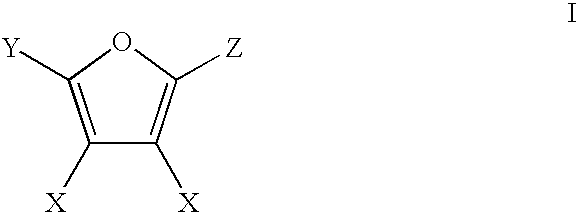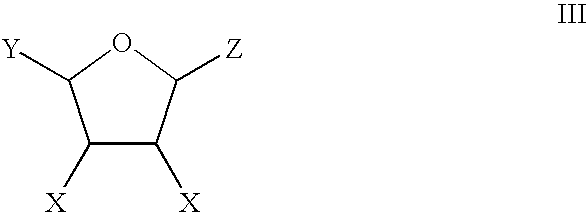Production of adipic acid and derivatives from carbohydrate-containing materials
a technology of adipic acid and derivatives, which is applied in the field of chemocatalytic conversion of a carbohydrate source to an adipic acid product, can solve the problems of adversely affecting the us economy, no process for producing adipic acid from biorenewable feedstocks has been commercialized, and oil prices to record levels
- Summary
- Abstract
- Description
- Claims
- Application Information
AI Technical Summary
Problems solved by technology
Method used
Image
Examples
examples
[0082]The following non-limiting examples are provided to further illustrate the present invention.
[0083]Reactions were conducted in 1 mL glass vials housed in a pressurized vessel in accordance with the procedures described in the examples below. Product yields were determined using mass spectrometry through comparison with calibration standards.
Preparation of M1 / Silica Catalysts (M1=Rh, Pd, Pt)
[0084]2 g of dried 5 μm Silica Cariact (Fuji Silysia) was weighed into vials. Suitably concentrated M1 stock solutions (M1=Rh, Pd, Pt) were prepared from concentrated acidic stock solutions purchased from Heraeus (see Table 1). For each M1, multiple additions of the dilute M1 stock solution were added to the silica (silica pore volume=0.7 mL / g) until a total volume of 1.4 ml was reached. After each addition, the mixtures were agitated to impregnate the silica. Post impregnation, the M1 / Silica mixtures were dried in a furnace at 120° C. for 12 hours, followed by calcination at 500° C. for 3 h...
PUM
| Property | Measurement | Unit |
|---|---|---|
| temperature | aaaaa | aaaaa |
| temperature | aaaaa | aaaaa |
| reaction temperature | aaaaa | aaaaa |
Abstract
Description
Claims
Application Information
 Login to View More
Login to View More - R&D
- Intellectual Property
- Life Sciences
- Materials
- Tech Scout
- Unparalleled Data Quality
- Higher Quality Content
- 60% Fewer Hallucinations
Browse by: Latest US Patents, China's latest patents, Technical Efficacy Thesaurus, Application Domain, Technology Topic, Popular Technical Reports.
© 2025 PatSnap. All rights reserved.Legal|Privacy policy|Modern Slavery Act Transparency Statement|Sitemap|About US| Contact US: help@patsnap.com



